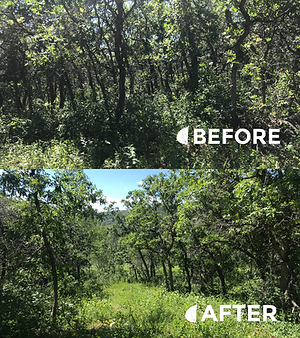PROJECT EXAMPLES

HAZARD TREE REMOVAL
Removing dead or diseased trees is important to prevent property damage. This large tree was at risk of falling on the client's roof. The trees posed a challenge to safely remove due to the tight space between the house and the tree location. NRSG's highly-skilled team were up for the task. The team safely and successfully brought the tree down in multiple smaller sections to reduce the risk of property damage and increase our teams safety.

DEFENSIBLE SPACE & FIRE MITIGATION
After a Fire Risk Assessment and Defensible Space Plan was initiated by NRSG, our experienced team decreased the continuity of fuels to reduce risk to wildfire within the home ignition zone and along the access road. Breaking up clumps of Gambel oak brush, pruning, and removing ladder fuels - lowering height of surrounding vegetation - can reduce the intensity or spread of wildfire. It can also open up surprising vistas. The NRSG team was also able to provide the client with some firewood, and removed associated slash to either burn or chip and haul off site. NRSG does not recommend retaining chips on site as they can reduce natural revegetation, can be easily ignited by embers, and difficult to extinguish. Defensible space needs to be maintained on an annual basis to be successful particularly around the first five feet against the house or structures. Recent research based on the fires in California have determined that embers are the leading cause of home loss. Creating and maintaining defensible space, and reducing your home's ignitability is a strategic proactive approach prior to a wildfire.

MASTICATION
This project was accomplishing the annual program of work under a client's Forest Ag Management Plan. Mastication is an important tool used to improve wildlife browse and habitat and reduce the intensity of wildfire. NRSG masticates to remove entire trees and shrubs. Mastication leaves large shreds to protect the soil from erosion and allows revegetation to occur. This is unlike chipping which is smaller and tends to consolidate and reduce regeneration when left on site. The NRSG team cut swaths in a mosaic pattern here to break up the continuity of thick Gambel oak to reduce the intensity of wildfire and to provide new growth of aspen and oak that is more nutrious to elk and deer. NRSG treated this area in the fall, and by spring, you can see how natural it looks with all the regeneration. Our clients have already seen an increase in use by elk. The clients also enjoy walking through their property more easily.
